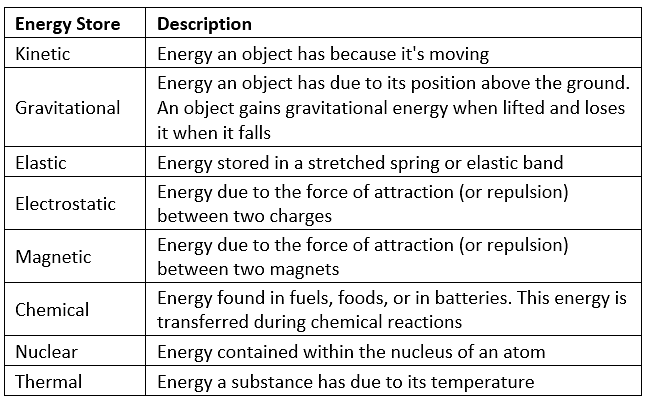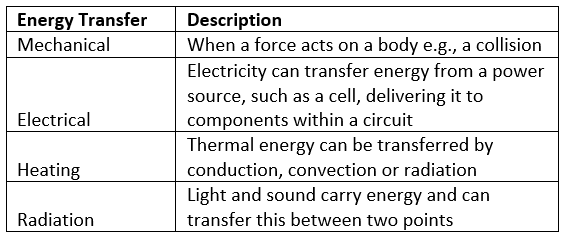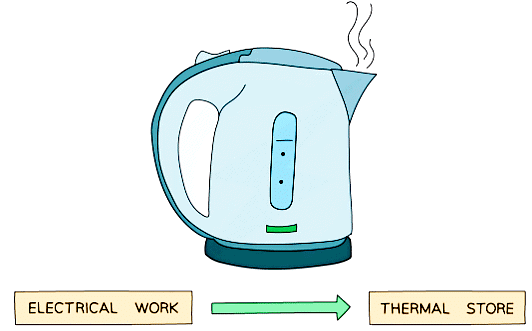Grade 10 Exam > Grade 10 Notes > Physics for Grade 10 > Energy Stores & Transfers
Energy Stores & Transfers | Physics for Grade 10 PDF Download
Systems in Physics
- Energy is a property that must be transferred to an object in order to perform work on or heat up that object
- It is measured in units of Joules (J)
- This is regardless of what type of energy is stored ie. kinetic or chemical
- Energy will often be described as part of an energy system
- In physics, a system is defined as:
An object or group of objects
- Therefore, when describing the changes within a system, only the objects or group of objects and the surroundings need to be considered
- A thermodynamic system, for example, can be isolated, closed or open
- An open system allows the exchange of energy and matter to or from its surroundings
- A closed system can exchange energy but not matter to or from its surroundings
- An isolated system does not allow the transfer of matter or energy to or from its surroundings
 A system can be open, closed or isolated
A system can be open, closed or isolated
Energy Stores & Transfers
Energy Stores
- Energy can be stored in different ways, and there are changes in the way it is stored when a system changes
- The principle of conservation of energy states that:
Energy cannot be created or destroyed, it can only be transferred from one store to another - This means that for a closed system, the total amount of energy is constant
- There are many different ways that energy can be stored, these are shown in the table below:
Types of Energy Stores Table

Energy Transfers
A system can change between stores through different energy transfer mechanisms
Examples of these are:
- Mechanical
- Electrical
- Heating
- Radiation
These are described in the table below:
Types of Energy Transfers Table
An example of a thermal energy transfer is a hot coffee heating up cold hands
 Thermal energy is transferred from the hot coffee to the mug and to the cold hands
Thermal energy is transferred from the hot coffee to the mug and to the cold hands
Examples of Energy Transfer
Energy transfers occur all the time in various everyday circumstances
- Some common situations include
- When an object is projected upwards
- When a moving object hits an obstacle
- When an object is accelerated by a constant force
- When a vehicle speeds up or slows down
- When water is brought to a boil in an electric kettle
An Object Projected Upwards
- Before the ball is thrown upwards, the person holding the ball is a store of chemical energy
- When the ball is thrown, the chemical energy is converted into kinetic energy as the ball begins to move upwards
- As the height of the ball increases, the kinetic energy is converted into gravitational potential energy

A Moving Object Hitting an Obstacle
- When an object, such as a car, is moving, chemical energy from the fuel is converted into kinetic energy
- If the object hits an obstacle, such as a car hitting a wall, the speed of the car will decrease very quickly
- Therefore, the kinetic energy of the car will decrease
- In this scenario, most of the kinetic energy is converted to heat and sound between the car and the wall

A Vehicle Being Accelerated by a Constant Force
- When a vehicle is stationary, it stores chemical energy in the fuel
- When the vehicle speeds up, or accelerates, the chemical energy is converted into kinetic energy

A Vehicle Slowing Down
- When a vehicle is moving, it has kinetic energy
- As it slows down, or decelerates, the kinetic energy is converted to heat and sound between the tyres and the road

Boiling Water in a Kettle
- When an electric kettle is used to heat up water it uses electricity to increase the temperature of the heating element
- During this process, electrical energy is converted into heat energy

The document Energy Stores & Transfers | Physics for Grade 10 is a part of the Grade 10 Course Physics for Grade 10.
All you need of Grade 10 at this link: Grade 10
|
124 videos|149 docs|37 tests
|

|
Explore Courses for Grade 10 exam
|

|
Signup for Free!
Signup to see your scores go up within 7 days! Learn & Practice with 1000+ FREE Notes, Videos & Tests.
Related Searches
















